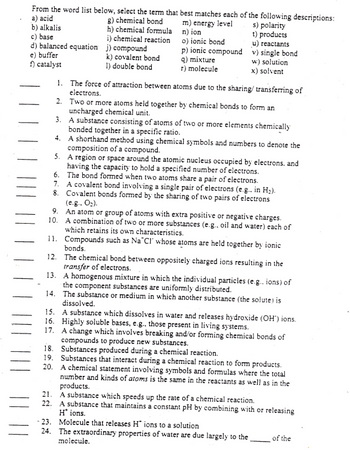From the word list below, select the term that best matches each of the following descriptions: a) acid b) alkalis g) chemical bond h) chemical formula i) chemical reaction m) energy level n) ion o) ionic bond c) base d) balanced equation j) compound e) buffer p) ionic compound q) mixture s) polarity t) products u) reactants v) single bond w) solution x) solvent f) catalyst r) molecule k) covalent bond 1) double bond 1. The force of attraction between atoms due to the sharing/ transferring of electrons. 2. Two or more atoms held together by chemical bonds to form an uncharged chemical unit. 3. A substance consisting of atoms of two or more elements chemically bonded together in a specific ratio. 4. A shorthand method using chemical symbols and numbers to denote the composition of a compound. 5. A region or space around the atomic nucleus occupied by electrons, and having the capacity to hold a specified number of electrons. 6. The bond formed when two atoms share a pair of electrons. 7. A covalent bond involving a single pair of electrons (e.g.. in H₂). 8. Covalent bonds formed by the sharing of two pairs of electrons (e.g., O₂). 10. 9. An atom or group of atoms with extra positive or negative charges. A combination of two or more substances (e.g., oil and water) each of which retains its own characteristics.
States of Matter
The substance that constitutes everything in the universe is known as matter. Matter comprises atoms which in turn are composed of electrons, protons, and neutrons. Different atoms combine together to give rise to molecules that act as a foundation for all kinds of substances. There are five states of matter based on their energies of attraction, namely solid, liquid, gases, plasma, and BEC (Bose-Einstein condensates).
Chemical Reactions and Equations
When a chemical species is transformed into another chemical species it is said to have undergone a chemical reaction. It consists of breaking existing bonds and forming new bonds by changing the position of electrons. These reactions are best explained using a chemical equation.

Trending now
This is a popular solution!
Step by step
Solved in 3 steps

Please answers 24 all









